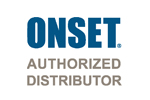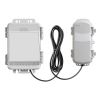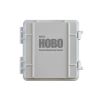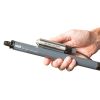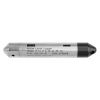HOBO MicroRX Water Level Station
Features
- Eliminate complicated manual calculations with pre-programmed water flow formulas
- Act quickly in response to alarms triggered at time of measurement for water flow and accumulated rainfall
- Reduce maintenance visits with the non-vented water level sensor
- Free ground shipping
- Expedited repair and warranty service
- Lifetime technical support
- More
Overview
The Onset HOBO MicroRX Water Level Station is a cellular, web-enabled water level monitoring solution for stormwater, floodwater, irrigation, hydrologic, and environmental applications. Pre-programmed water flow formulas for select weirs, flumes, and a stage discharge table result in an easy and intuitive configuration.
Mechanics
New water flow and accumulated rainfall calculations, which are performed directly on the station at time of measurement, trigger immediate notifications of critical water level conditions. The compact and durable station, together with the non-vented water level sensor, enables harsh condition deployments and reliable monitoring. The optional integrated solar panel or battery power, with a wide range of plug-and-play smart sensors, supports flexible environmental monitoring.
Benefits
- Station-side alarms for water flow and accumulated rainfall triggered at time of measurement
- Non-vented ceramic water level sensor with a choice of four ranges
- Interchangeable, Kevlar-reinforced water level sensor cables
- Integrated barometric pressure sensor
- Compact IP66/NEMA 4X enclosure
- Built-in LCD confirms proper setup and operation
- Two power options:
- Integrated 1.7 W solar panel with rechargeable battery pack
- 5 W and 15 W external solar panels can be added (RX2104 only)
- User-replaceable AA lithium batteries
- Inputs for five plug-and-play sensors
- Up to 10-minute connections rates via 4G cellular data plans
- Cloud-based monitoring and data access through HOBOlink
- Available with stainless steel or titanium sensor ends
- 3-point NIST-traceable calibration certificate included for the water pressure sensor
In The News
Spring 2025 Environmental Monitor Available Now
In the Spring 2025 edition of the Environmental Monitor, we highlight partnerships across the world and the importance of collaboration between government agencies, universities, environmental groups, local communities, and other stakeholders. From great white shark research in Cape Cod to monitoring fisheries in Lake Erie, this latest edition underscores partnerships that connect stakeholders in a watershed through environmental data. With an emphasis on data sharing, a combination of real-time and discrete sampling keeps the public and partners informed of environmental conditions. Our writers also sought out science professionals dedicated to working with peers within and outside of the environmental sector.
Read MoreMonitoring Mariculture in the Gulf of Alaska
The mariculture industry in the Gulf of Alaska has been steadily growing in recent years, guided by ongoing research to help refine farm location and cultivation practices. A subset of aquaculture, mariculture focuses on rearing organisms in the open ocean. In Alaska, finfish farming is illegal, so most farms cultivate kelp, oysters, or a combination of the two. These small, locally operated farms started popping up in the Gulf of Alaska in the early 1990s, when shellfish farming first became legal. Kelp farming did not begin to catch on in the state until 2016. Many of the coastal areas that have grown interested in mariculture are historically commercial fishing communities.
Read MoreSupplying Seattle’s Drinking Water: Using Data Buoys to Monitor the Cedar River Municipal Watershed
Providing clean, safe, and reliable drinking water for the 1.6 million people in the greater Seattle area is a top priority for Seattle Public Utilities (SPU). With limited water supplies, SPU dedicates considerable resources to maintain its watersheds and mountain reservoirs. About 70 percent of Seattle Water comes from the Cedar River Municipal Watershed , and the other 30 percent comes from the South Fork Tolt River Watershed . [caption id="attachment_39574" align="alignnone" width="940"] Data buoy in Chester Morse Lake . (Credit: Kevin Johnson / Seattle Public Utilities) [/caption] Jamie Thompson, a fisheries biologist at SPU, monitors aquatic ecosystems centered on fish listed under the U.S. Endangered Species Act (ESA).
Read More
















